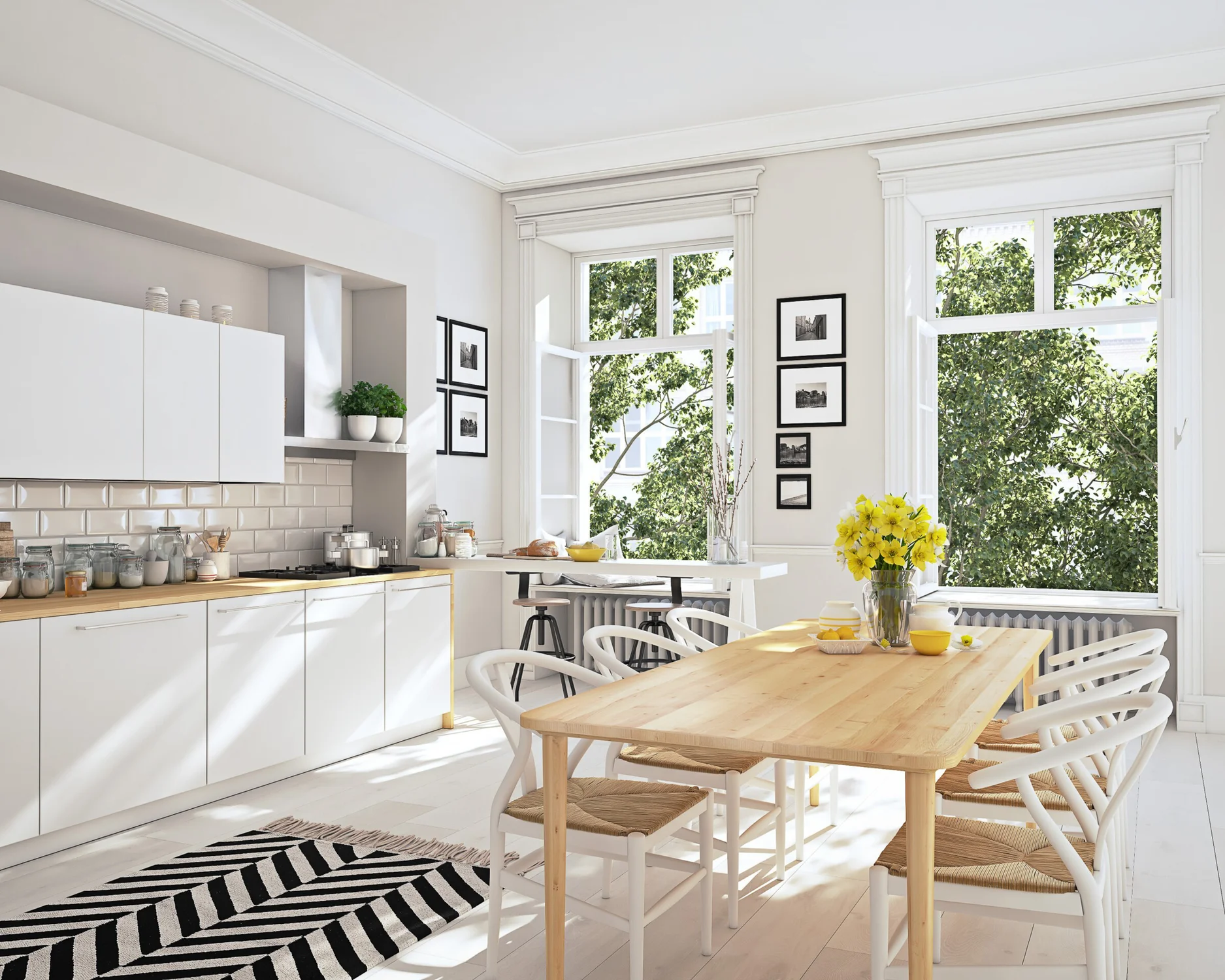In the previous article, I discussed minimalist interiors with two popular designs (Japanese and Industrial styles). And, at this time, I would like to share with you about two minimalist styles that are also popular all over the world. That is Scandinavian and Urban styles
Read more: Minimalist interior design with Industrial and Japanese Styles
Scandinavian Minimalist Interior Design
Overview of Scandinavian minimalist style
The Scandinavian style is also a common style for minimalist interior design because of its connection with the natural world. This style started at the beginning of the 20th century in Nordic countries (Denmark, Finland, Norway, Sweden, and Iceland). Then, it spread to all of Europe and finally to the whole world. People can easily recognize this style by its simplicity, functionality, and calmness. It is also sunk in natural sunlight and light color palettes. As a Japanese minimalist design, the Scandinavian style also focuses on wood furniture and indoor trees to make your home more friendly to the natural environment.
Who suits this style?
This style is a good choice for those who love nature and want to connect it to their house with large windows and some indoor trees. It will especially be perfect for those who live in the countryside or outskirts where you can easily own land surrounded by natural landscapes. Or, if you are a calm person, the Scandinavian minimalist design will fit you so well. It will bring a cozy and inviting space into your house.
Advantages and disadvantages
If you want to build your home following the Scandinavian style, you should have a look at its pros and cons before you implement it.
Pros
- Timeless Aesthetic: The age of this style is more than 100 years, and it is still popular in the modern world, especially in Europe. This is a proof that demonstrates the timelessness of this style
- Connection to Nature: Your home connects to nature through large windows and trees that will help you enhance your health.
- Environmental Benefits: this interior design will focus on eco-friendly materials and designs, that will help limit plastic trash in the environment
Cons
- Higher Initial Costs: the cost will mainly come from furniture and decorative elements. Almost all furniture is made of wood and decor pieces usually are designed items made by artists which are quite expensive.
- Personalization Challenges: The Scandinavian minimalist design is popular and has existed for a long time. Therefore, if you want to make your home more unique and personal, it will not be easy.
- Maintenance: In this design, light colors will be the main palette of the house. Therefore, it will be easy to get dirty and make the maintenance work more difficult.
Tips and ideas for a design of Scandinavian minimalist
- Light color palettes: This style is extraordinary with light hues, they will make the space look larger and minimalist. Besides light hues, you can also try colors such as cool neutrals and warm beiges.
- Natural Materials: To have a beautiful Scandinavian design, natural material is a must. You can consider natural stone or wood floors, furniture with light woods like pine, birch, or oak, and textile-based items made of hemp, sisal, or wool
- Natural Light: This is an essential element when you build your house following Scandinavian style, let’s ensure that your home has enough natural light by large windows and light curtains. Sometimes, if you want to block all the light you can consider two-layer curtains
- Houseplants: Indoor trees play an important role in this design, they will help your house look more friendly and diving in “Mother Nature”
Urban Minimalist Interior Design
Overview of Urban minimalist style
Urban minimalist style is created by a combination of modern, industrial, and contemporary. This style has a softer, more inviting, and comfortable look compared with the industrial style. It also evokes the feeling of modern and contemporary through smart devices and up-to-date equipment such as smart home hubs, modern TVs, Air Purifier, the vacuum robot cleaner
Who suits this style?
This style is a good match for city dwellers, because it will help a small space become more functional and practical, even look wider. Or, If the homeowner is always curious about the latest technology and follows modernism, he can choose the urban minimalist style to suit his lifestyle.
Advantages and disadvantages
Every style has its pros and cons and Urban minimalist style is not an exception, let’s have a look and see if this style suits your home or not.
Pros
- Maximized Space Efficiency: In this style, Furniture is usually a modern type with multiple functions that help you utilize available space as much as possible.
- Modern and Stylish: Urban design will blow a new wind with modernness and stylishness
- Create a productivity feeling: A combination of minimalist design and modernness also helps you increase focus and productivity.
Cons
- Increase electric bill: There are a lot of smart devices and equipment in the urban minimalist design. They will increase the power consumption of your entire house.
- Fire risk from the battery: Some smart devices use batteries instead of direct power, which will put your home at high risk of fire
- Uncomfortable for elderly men: Because of the modernness, some elderly people will meet difficulty in usage without any guideline
Tips and ideas for a design of Urban minimalist
- Modern Lighting: Besides the natural light, let’s try some modern lighting fixtures. There are a variety of stylish and functional designs that help your home look more stunning and attractive.
- Multi-functional Furniture: In Urban minimalist interior design, multi-functional furniture plays an important role, it not only brings convenience and modernness to your home but also utilizes space effectively
- Incorporate Industrial Elements: If you want to make your home look sharper and stronger. You can consider the combination with some industrial elements such as shelves, fixtures, and other decorative accessories.
